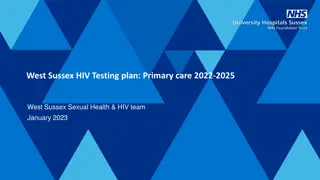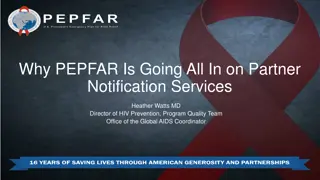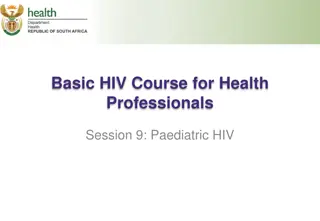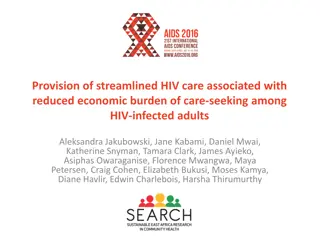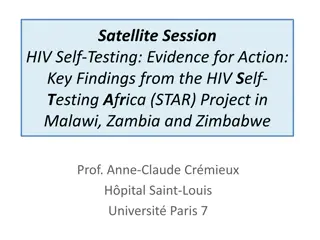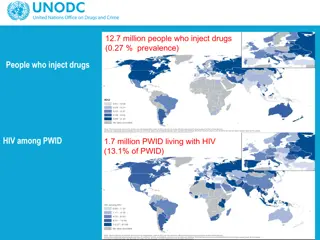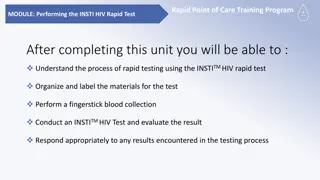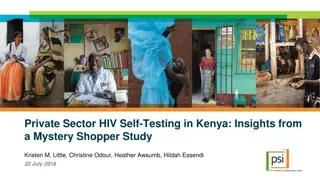Impact of Global Declines in HIV Testing and Service Disruptions on Future Healthcare
Global declines in HIV testing and reductions in new initiators, coupled with disruptions in HIV services due to COVID-19, pose challenges for future healthcare. Short-term disturbances could lead to increased HIV-related mortality, emphasizing the need for program responses to mitigate adverse effects. The risks and benefits of providing HIV services during the pandemic highlight the importance of maintaining HIV programs amidst disruptions to avert considerable HIV deaths.
Download Presentation

Please find below an Image/Link to download the presentation.
The content on the website is provided AS IS for your information and personal use only. It may not be sold, licensed, or shared on other websites without obtaining consent from the author.If you encounter any issues during the download, it is possible that the publisher has removed the file from their server.
You are allowed to download the files provided on this website for personal or commercial use, subject to the condition that they are used lawfully. All files are the property of their respective owners.
The content on the website is provided AS IS for your information and personal use only. It may not be sold, licensed, or shared on other websites without obtaining consent from the author.
E N D
Presentation Transcript
Global declines in HIV testing and reductions in new initiators - what does this mean for the future? John Stover Avenir Health
HIV Service Disruptions due to COVID-19 The COVID-19 epidemic has the potential to cause severe disruptions in health services due to several factors: Closing of facilities or cessation of services Shortage of health care workers Over-burdening of health care staff Disruptions in supplies for commodities and person protection equipment Travel restrictions Fear of accessing health facilities The effects of these disruptions on HIV testing, new infections, deaths will depend on the duration and severity of the disruptions and the program responses to them
Effects of COVID-related Service Disruptions Multi-model analysis organized by the HIV Modeling Consortium found Short-term disruptions in prevention services would have limited impact on HIV-related mortality Short-term disruptions of ART services could lead to 39-87% increase in HIV- related mortality in 2020 and 15-29% increase over 2020-2025 Assumptions Service disruption lasting 6 months Disruption affects 50% of the population Relative change in mortality is over 12 months (April 2020-March 2021) Source: Jewel, Mudimu, Stover, ten Brink, Philipps et al. Potential effects of disruptions to HIV programmes in sub-Saharan Africa caused by COVID-19: result from multiple mathematical models, Lancet HIV 2020, doi.org/10.1016/S2352-3018(20)30211-3 3
HIV deaths averted by HIV services are likely to be considerably larger than expected COVID-19 deaths Additional COVID-19 Deaths per 10,000 HIV Clients Discounted HIV Deaths Averted per 10,000 Clients 0.16 350 0.14 300 0.12 250 0.10 200 0.08 150 0.06 0.04 100 0.02 50 0.00 0 VMMC Condoms distribution HIV testing Viral load testing PMTCT VMMC HIV testing Viral load testing PMTCT Avenir Health CooperSmith COVASIM Goals HIV Synthesis Optima Source: Stover J et al. The Risks and Benefits of Providing HIV Services during the COVID-19 Pandemic. https://medrxiv.org/cgi/content/short/2021.03.01.21252663v1 4
Percent change in the number of HIV tests conducted and results returned compared to baseline, by month, 2020 Countries with between 150 000 and 1.7 million tests in January/February 40% 20% 0% -20% -40% -60% -80% -100% South Africa Ethiopia Uganda Kenya United Republic of Tanzania Indonesia Mozambique Peru Rwanda Myanmar Mar Apr May Jun July Aug Sep Oct Countries with between 2 000 and 84 000 tests in January/February 120% 100% 80% 60% 40% 20% 0% -20% -40% -60% -80% -100% Tajikistan Lesotho Haiti Sierra Leone Guatemala Botswana Madagascar Georgia Liberia Honduras Jamaica Cambodia Armenia Guyana Mar Apr May Jun July Aug Sep Oct Source: UNAIDS/WHO/UNICEF HIV services tracking tool, December 2020. Note: The baseline is the average of January and February reports. Countries fulfilled the following criteria: (a) provided data for at least 6 months, including January and February 2020; (b) reported on at least 50 people receiving services in January; (c) had a least 50% of facilities reporting during the month; and (d) had at least six months of data.
Percent change in the number of people on antiretroviral treatment compared to baseline, by month, 2020 Countries with between 112 000 and 5.2 million people on treatment in January/February 30% 25% 20% 15% 10% 5% 0% -5% -10% South Africa Kenya Zimbabwe Mozambique Ethiopia Botswana Cameroon Lesotho Rwanda Myanmar Indonesia Ukraine Haiti Countries with between 1400 and 68 000 people on treatment in January/February 10% 5% 0% -5% -10% -15% Peru Dominican Republic Nepal Guatemala Jamaica Honduras Tajikistan Guyana Kyrgyzstan Armenia Barbados Mar Apr May Jun July Aug Sep Oct Source: UNAIDS/WHO/UNICEF HIV services tracking tool, December 2020. Note: The baseline is the average of January and February reports. Countries fulfilled the following criteria: (a) provided data for at least 6 months, including January and February 2020; (b) reported on at least 50 people receiving services in January; (c) had a least 50% of facilities reporting during the month; and (d) had at least six months of data.
Trends in Number of PLHIV Knowing their HIV Status 30,000,000 2,000,000 Annual Change in the Number Knowing Their Status 1,800,000 Number of PLHIV n SSA Who Know Their Status 25,000,000 1,600,000 1,400,000 20,000,000 1,200,000 15,000,000 1,000,000 800,000 10,000,000 600,000 400,000 5,000,000 200,000 0 0 2018 2019 2020 Number Knowing Their Status Annual change Source: UNAIDS aidsinfo online.org 7
Trends in Number on ART and Annual Change 30,000,000 2,500,000 Annual Change in the Number of People on ART 25,000,000 2,000,000 Global Number of People on ART 20,000,000 1,500,000 15,000,000 1,000,000 10,000,000 500,000 5,000,000 0 0 2010 2011 2012 2013 2014 2015 2016 2017 2018 2019 2020 Number on ART Annual change Source: UNAIDS aidsinfo online.org 8
Results Effects of disruptions will largely disappear by 2025 if we are able to catch-up to targets However, during 2020-2025 disruptions could lead to: 120,000 - 290,000 new HIV infections 70,000 150,000 additional AIDS deaths Source: UNAIDS, Prevailing Against Pandemics by Putting People at the Centre, World AIDS Day Report, 2020. 9
Conclusion Disruptions in HIV services due to COVID-19 are evident in program data, but most programs seem to have responded well to the challenges of maintaining essential HIV services Continued support for these efforts is essential to averting a potential significant increase in HIV-related deaths 10







